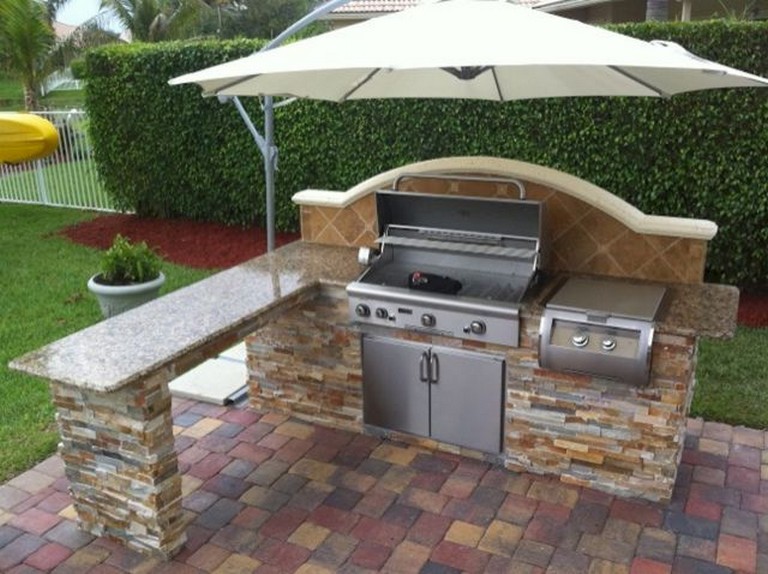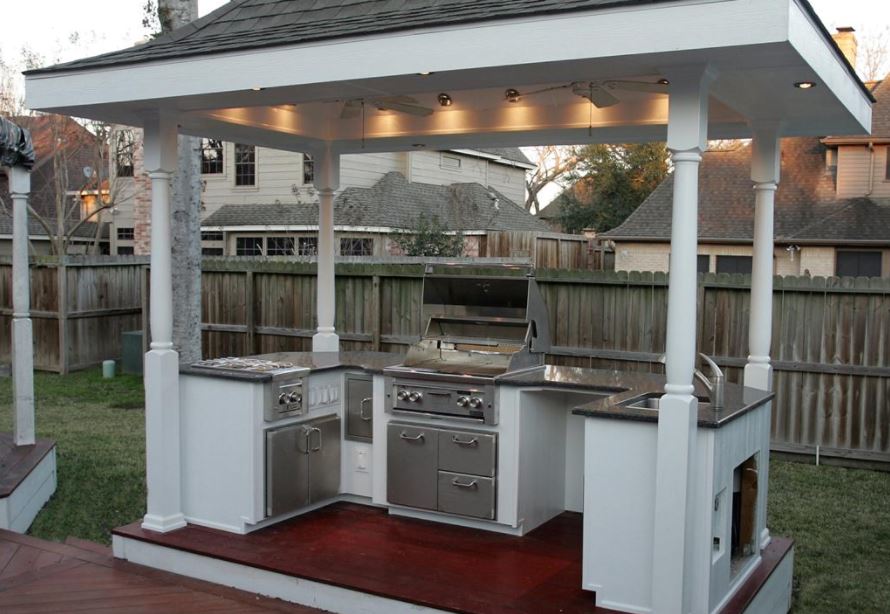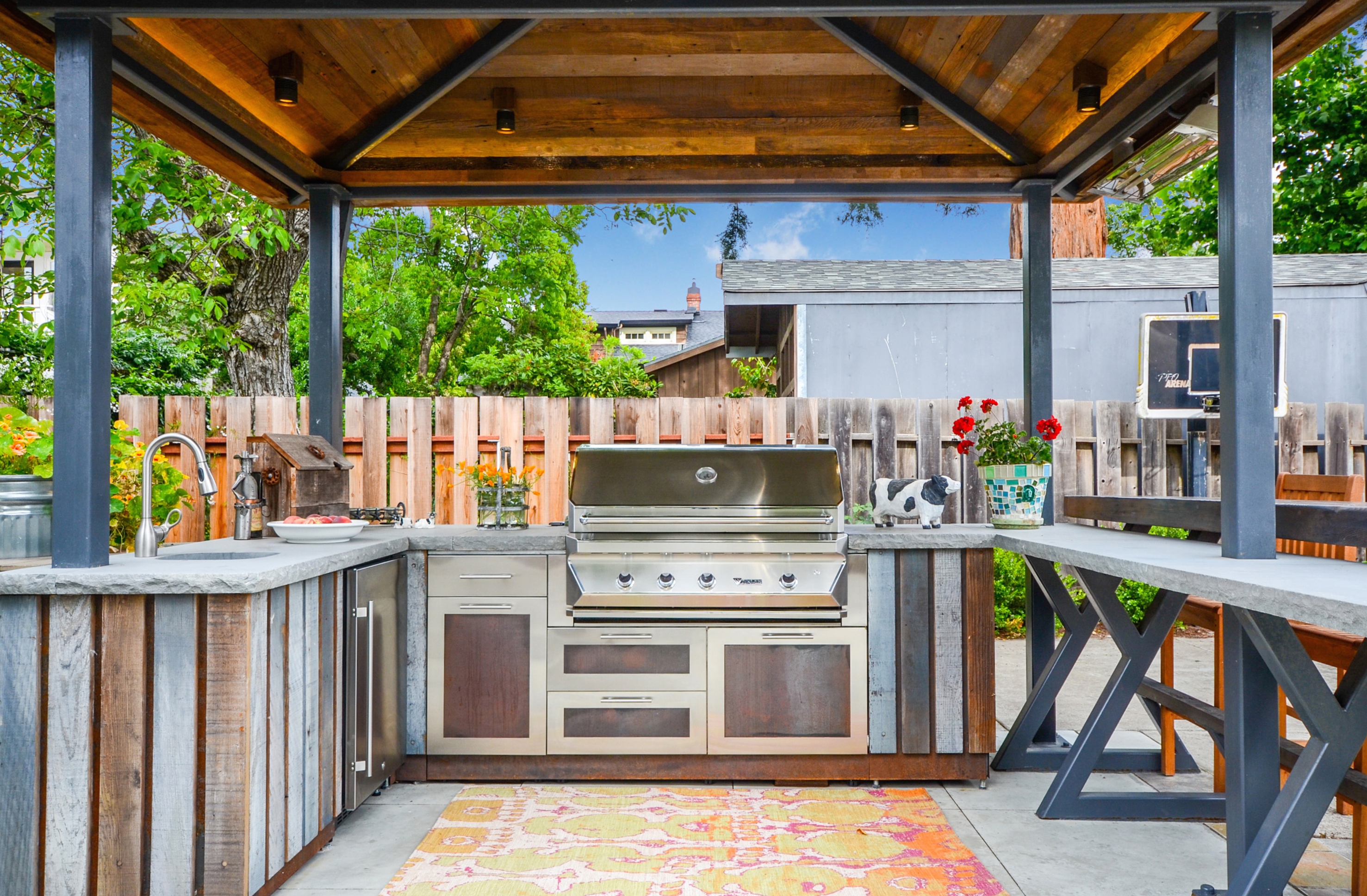Designing an outdoor kitchen with a limited budget doesn't mean sacrificing style or functionality. With careful planning, creative choices, and a little DIY spirit, you can transform your backyard into a culinary oasis without breaking the bank. From selecting the right materials and appliances to crafting a layout that maximizes space, this guide will empower you to build the outdoor kitchen of your dreams, even on a tight budget.
The key to success lies in prioritizing your needs, exploring cost-effective alternatives, and embracing resourceful solutions. This guide will walk you through each step of the process, from initial planning to adding those finishing touches that will make your outdoor kitchen truly special.
Planning and Budgeting

Planning and budgeting are crucial steps in designing your outdoor kitchen, especially when working with a limited budget. A well-thought-out plan ensures you get the most out of your investment while staying within your financial constraints.
Essential Features and Functions
Before you start planning, consider the essential features and functions you need in your outdoor kitchen. This will help you prioritize your spending and avoid unnecessary expenses.
- Cooking Area: This is the heart of your outdoor kitchen. Decide if you need a grill, a stovetop, an oven, or a combination of these.
- Food Preparation Area: Include a countertop for food prep, a sink for washing, and storage space for utensils and ingredients.
- Seating and Dining: Determine the seating capacity you need and whether you want a dining table or a bar area.
- Storage: Plan for storage space for your cooking equipment, tableware, and other essentials.
- Lighting: Adequate lighting is essential for safety and ambiance. Consider both task lighting for cooking and ambient lighting for relaxation.
- Protection from the Elements: Think about how you will protect your outdoor kitchen from rain, sun, and wind. This could include a roof, awnings, or retractable screens.
Material and Appliance Costs
Researching and comparing costs for different materials, appliances, and fixtures is essential for budgeting effectively.
- Materials: Consider the cost of countertops (granite, quartz, concrete, or tile), cabinets (wood, metal, or plastic), and flooring (pavers, decking, or concrete).
- Appliances: Grill prices vary widely based on size, fuel type (gas, charcoal, or electric), and features. Stovetops, ovens, and refrigerators also have a wide range of price points.
- Fixtures: Don't forget to factor in the cost of sinks, faucets, lighting fixtures, and any other accessories you want to include.
Budget Breakdown
Create a detailed budget breakdown, allocating funds for each component of your outdoor kitchen.
A good rule of thumb is to allocate 60-70% of your budget to the main cooking area, 15-20% to food prep and storage, and 10-15% to seating, dining, and lighting.
| Component | Estimated Cost |
|---|---|
| Cooking Area (Grill, Stovetop, Oven) | $1,000 - $5,000+ |
| Food Prep and Storage (Countertops, Cabinets, Sink) | $500 - $2,000+ |
| Seating and Dining (Table, Chairs, Bar Area) | $200 - $1,000+ |
| Lighting (Fixtures, Wiring) | $100 - $500+ |
| Protection from the Elements (Roof, Awning, Screens) | $200 - $2,000+ |
DIY Options and Cost Savings
Exploring DIY options can significantly reduce your overall costs.
- Building Cabinets and Countertops: With some basic woodworking skills, you can build your own cabinets and countertops, saving money on pre-made units.
- Installing Appliances: Installing appliances yourself can also save on labor costs.
- Landscaping and Hardscaping: Creating your own landscaping and hardscaping features can add a personal touch and save on professional fees.
Prioritizing Features and Making Compromises, Designing an outdoor kitchen with a limited budget
Prioritize essential features and make compromises where necessary to stay within your budget.
- Choose a Budget-Friendly Grill: Consider a charcoal grill or a basic gas grill instead of a high-end model with all the bells and whistles.
- Opt for Simple Cabinets: Instead of custom-built cabinets, consider ready-made cabinets from a home improvement store.
- DIY Where Possible: Take on DIY projects to save on labor costs.
- Shop Around for Appliances: Compare prices from different retailers and consider buying appliances during sales or clearance events.
Choosing the Right Location and Design

The location and design of your outdoor kitchen are crucial for creating a functional and enjoyable space. Carefully considering factors like available space, sunlight, shade, and privacy will help you create an outdoor kitchen that meets your needs and complements your existing landscape.
Evaluating Available Space and Factors
The first step is to evaluate the available space and identify potential challenges.
- Sunlight and Shade: Consider how much sunlight the chosen location receives throughout the day. Direct sunlight can be great for cooking and entertaining, but too much can make the space uncomfortable. Conversely, too much shade can make it difficult to cook or enjoy the outdoors. Consider adding shade structures like pergolas or awnings to create a balance.
- Privacy: Think about the level of privacy you desire. If you want a secluded space, consider placing your outdoor kitchen in a corner of your yard or behind a fence. You can also use landscaping elements like trees and shrubs to create a sense of privacy.
- Access to Utilities: Consider the proximity to water, gas, and electricity sources. These connections are essential for appliances and lighting, and the closer they are, the less expensive and easier the installation will be.
- Existing Structures: Evaluate the existing structures on your property, such as patios, decks, or existing buildings. These can be incorporated into your outdoor kitchen design to create a seamless flow and maximize space.
Designing a Layout for Functionality and Flow
Once you've evaluated the available space and factors, you can start designing the layout.
- Work Triangle: The work triangle is a concept used in kitchen design that focuses on the efficient placement of the refrigerator, sink, and cooking appliances. In an outdoor kitchen, the work triangle should be designed to optimize functionality and flow. Keep the distance between these elements manageable for easy movement and access.
- Traffic Flow: Consider the flow of traffic in and around the outdoor kitchen. Make sure there is enough space for people to move around comfortably, especially if you plan to host large gatherings.
- Seating Areas: Determine the size and placement of seating areas. Consider the number of guests you plan to accommodate and the desired proximity to the cooking area.
Choosing Appliances, Countertops, and Seating
- Appliances: Choose appliances that are suitable for outdoor use and fit within your budget. Consider features like built-in grills, refrigerators, and even pizza ovens. Remember to choose appliances that are weather-resistant and durable.
- Countertops: Countertop materials should be durable, weather-resistant, and easy to clean. Popular options include granite, concrete, and stainless steel. Consider the overall style of your outdoor kitchen and choose a countertop material that complements the design.
- Seating: Select comfortable and durable seating options that complement the style of your outdoor kitchen. Consider materials like teak, wicker, or metal, which are weather-resistant and long-lasting.
Exploring Design Styles and Themes
There are many different design styles and themes to choose from, so it's important to consider your preferences and the overall aesthetic of your home.
- Modern: Clean lines, minimalist design, and a focus on functionality are key characteristics of a modern outdoor kitchen. Use materials like stainless steel, concrete, and sleek cabinetry.
- Rustic: A rustic outdoor kitchen evokes a sense of warmth and natural beauty. Use materials like wood, stone, and wrought iron. Incorporate elements like reclaimed wood or exposed brick.
- Mediterranean: A Mediterranean-inspired outdoor kitchen features warm colors, terracotta tiles, and wrought iron accents. Use plants like rosemary, lavender, and olive trees to create a vibrant and inviting atmosphere.
Incorporating Sustainable and Eco-Friendly Design Elements
Sustainability is becoming increasingly important in all aspects of design, and outdoor kitchens are no exception.
- Energy-Efficient Appliances: Choose appliances that are energy-efficient and use less energy, which can help reduce your carbon footprint and save money on your energy bills. Look for appliances with ENERGY STAR certification.
- Water Conservation: Install water-saving fixtures in your outdoor kitchen, such as low-flow faucets and showerheads. Consider using a rainwater harvesting system to collect and reuse rainwater for irrigation.
- Recycled and Sustainable Materials: Choose materials that are recycled or sustainably sourced. This includes wood from sustainably managed forests, recycled plastic, and salvaged materials.
Selecting Materials and Appliances: Designing An Outdoor Kitchen With A Limited Budget

Now that you've planned your outdoor kitchen and established your budget, it's time to choose the materials and appliances that will bring your vision to life. This step is crucial as it determines the functionality, aesthetics, and longevity of your outdoor cooking space.
Countertop Materials
The countertop is the heart of your outdoor kitchen, where you'll prepare and cook your meals. Choosing the right material is essential for durability, aesthetics, and cost-effectiveness.
- Granite: Known for its natural beauty, durability, and heat resistance. Granite is a popular choice for outdoor kitchens, but it can be expensive.
- Quartz: Engineered stone, offering a wide range of colors and patterns. Quartz is non-porous, making it resistant to stains and bacteria. While it is generally more affordable than granite, it's still a relatively expensive option.
- Concrete: A versatile and affordable material that can be customized with various colors, textures, and finishes. Concrete is durable and heat-resistant, making it a good choice for outdoor kitchens.
- Tile: Ceramic or porcelain tiles offer a wide range of designs and colors, allowing you to create a unique look for your outdoor kitchen. Tile is generally more affordable than natural stone, but it requires more maintenance.
- Stainless Steel: A durable and easy-to-clean material that is often used for countertops in professional kitchens. Stainless steel is resistant to heat and scratches, making it a practical choice for outdoor kitchens.
Appliance Selection
Choosing the right appliances is essential for creating a functional and enjoyable outdoor kitchen experience.
- Grills: Gas grills offer quick and even heating, while charcoal grills provide a more traditional smoky flavor. Consider the size, features, and fuel type to meet your needs.
- Ovens: Outdoor ovens are becoming increasingly popular, allowing you to bake, roast, and even smoke food outdoors. Look for ovens with features like temperature control, multiple cooking modes, and easy-to-clean surfaces.
- Refrigerators: A dedicated outdoor refrigerator keeps your food and drinks cool and accessible. Choose a refrigerator with features like adjustable shelves, a freezer compartment, and a weatherproof design.
Alternative Appliance Options
For budget-conscious outdoor kitchen enthusiasts, there are several alternative appliance options available.
- Portable Grills: Portable grills are an affordable and convenient option for smaller outdoor kitchens or for those who don't want to invest in a full-sized grill.
- Pizza Ovens: Outdoor pizza ovens can be a fun and affordable way to enjoy homemade pizza outdoors.
- Cooler Boxes: Cooler boxes are a cost-effective alternative to a dedicated outdoor refrigerator, especially for smaller gatherings.
Reclaimed and Repurposed Materials
Using reclaimed or repurposed materials can help you save money and reduce waste.
- Old Doors: Repurposed doors can be used as cabinet doors, counter tops, or even as a backsplash.
- Pallets: Pallets can be disassembled and used to build furniture, shelving, or even a bar area.
- Recycled Bricks: Recycled bricks can be used to build a pizza oven, a fire pit, or even a decorative wall.
Storage Solutions
Adequate storage is essential for keeping your outdoor kitchen organized and functional.
- Cabinets: Cabinets provide a convenient way to store appliances, cooking essentials, and tableware.
- Shelves: Open shelves offer easy access to frequently used items, while closed shelves provide protection from the elements.
- Drawers: Drawers are great for storing smaller items like utensils, spices, and cleaning supplies.
Building the Outdoor Kitchen

With the planning and design complete, it's time to get your hands dirty and start building your outdoor kitchen. This phase requires careful consideration of your budget, skill level, and the overall design.
Construction Methods and Techniques
The construction methods you choose will depend on your budget and skill level. For example, if you are comfortable with basic carpentry and have a limited budget, you can build a simple outdoor kitchen using readily available materials like pressure-treated lumber and plywood. However, if you are aiming for a more sophisticated look or have a larger budget, you may consider hiring a professional contractor or using pre-fabricated cabinets and countertops.
- DIY Techniques: Building cabinets and countertops can be a rewarding DIY project. Numerous online resources and tutorials provide step-by-step instructions for building cabinets using plywood and lumber. For countertops, you can use materials like concrete, pavers, or even recycled materials like reclaimed wood or repurposed tiles.
- Prefabricated Options: If you prefer a more streamlined approach or lack carpentry skills, consider using prefabricated cabinets and countertops. These options are readily available at home improvement stores and online retailers, offering a variety of styles and materials to suit your design.
- Professional Installation: For complex designs or intricate features, hiring a professional contractor is a wise decision. They can handle the installation of plumbing, electrical wiring, and ensure proper building codes are met.
Building the Structure
The structure of your outdoor kitchen will depend on the size and complexity of your design. For a simple setup, you may only need to build a frame using pressure-treated lumber and plywood. For more elaborate designs, you may need to construct a full-fledged outdoor kitchen structure with walls, a roof, and even a dedicated space for appliances.
- Frame Construction: Start by building a sturdy frame using pressure-treated lumber for the base and support posts. Ensure the frame is level and plumb.
- Wall Construction: If your design includes walls, you can use plywood or other suitable materials for the sheathing. You may want to consider adding insulation to the walls for added warmth and noise reduction.
- Roof Construction: If your design includes a roof, choose a suitable material like corrugated metal, asphalt shingles, or even a pergola design. Ensure the roof is properly supported and waterproofed.
Installing Appliances
Installing appliances in your outdoor kitchen requires careful planning and execution. Ensure proper ventilation and electrical connections for each appliance.
- Ventilation: Adequate ventilation is crucial for outdoor kitchens, especially when using gas grills or other appliances that produce fumes. Consider installing a range hood or using a vent fan for proper air circulation.
- Electrical Connections: Consult with an electrician to ensure proper electrical connections for all appliances. Use weatherproof outlets and wiring for outdoor use.
- Appliance Installation: Carefully follow the manufacturer's instructions for installing appliances. Ensure the appliances are level and secure.
Adding Finishing Touches
Once the structure and appliances are in place, it's time to add the finishing touches that will make your outdoor kitchen truly special.
- Countertops: Choose a durable and weather-resistant countertop material like concrete, granite, or pavers. You can also use recycled materials like reclaimed wood or repurposed tiles.
- Cabinets: Install cabinets for storage and organization. Choose materials like pressure-treated lumber, stainless steel, or even repurposed furniture.
- Lighting: Install lighting for nighttime use. Consider using LED lights for energy efficiency and longevity.
- Safety Features: Install safety features like fire extinguishers, smoke detectors, and ground fault circuit interrupters (GFCIs) for electrical outlets.
Adding Finishing Touches

After you've built the structure of your outdoor kitchen, it's time to add the finishing touches that will transform it into a truly inviting and functional space. These details will enhance the overall aesthetic appeal and create a welcoming atmosphere for you and your guests.
Creating a Comfortable Seating Area
A comfortable seating area is essential for enjoying your outdoor kitchen. Consider the size of your space and the number of people you typically entertain when choosing seating.
- Chairs: Choose chairs that are comfortable and durable, and that complement the style of your kitchen. Patio chairs, Adirondack chairs, or even folding chairs can work well. You can find affordable options at most home improvement stores.
- Benches: Benches are a great option for providing additional seating and creating a more casual atmosphere. They can be made from wood, metal, or concrete, and can be purchased or built yourself.
Closing Notes

Creating an outdoor kitchen on a budget is a rewarding journey that combines creativity, practicality, and a touch of DIY magic. By following the steps Artikeld in this guide, you can enjoy the benefits of an outdoor kitchen that's both beautiful and functional, without exceeding your budget. Remember, the most important ingredient is your passion for outdoor living, and with a little planning and ingenuity, your dream outdoor kitchen is within reach.
FAQ Corner
What are some essential features for a budget-friendly outdoor kitchen?
A good grill, a prep area with countertop space, and some basic storage are essential for a functional outdoor kitchen. Consider a small refrigerator or cooler for beverages and food storage.
Can I use reclaimed materials for my outdoor kitchen?
Absolutely! Reclaimed wood, brick, or even old furniture can add character and save you money. Just be sure to treat the materials appropriately for outdoor use.
What are some budget-friendly ways to add ambiance to my outdoor kitchen?
String lights, lanterns, and fire pits are great for creating a cozy atmosphere. Plants and flowers add natural beauty, and you can often find affordable options at local nurseries or garden centers.
